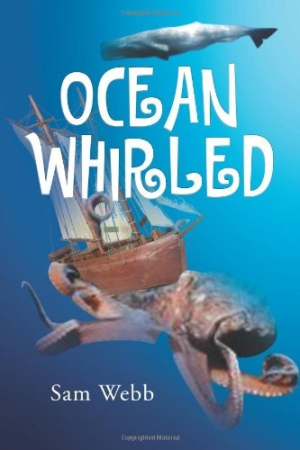
Ocean Whirled
With a fast pace and vivid world building, this story of merfolk is eminently readable.
Stories of merfolk who can venture onto land have been popular since Hans Christian Andersen’s The Little Mermaid. In a similar vein, Sam Webb’s Ocean Whirled tells the story of a culture of merfolk known as N’harmae who can have tails in the water and legs on land.
A deadly force has wiped out most of the N’harmae, leaving only a few to frolic with dolphins, whales, nymphs, and dryads. A young N’harmae man named Penure brings the inhabitants of the sea together so they can save themselves from extinction at the hands of a jellyfish-like alien race called the Vi’red. For Penure, this means seeking out more of his kind, learning that he can gain legs to go on land, and allying with the possibly dangerous species known as humans.
Themes of family, destiny, and environmental preservation abound in this coming-of-age story sure to delight teens and adults. The tale is set on a planet similar to Earth where the humans are not as technically advanced as those in the twenty-first century. The culture of the merfolk includes its own form of measurement and its own language (helpfully translated by context clues and a glossary).
The plot moves quickly, characters pop off the page, and world-building is done vividly as the book masterfully uses third-person limited omniscient narration to tell the story from multiple perspectives. After introducing the group of heroes in separate chapters, the narrative smoothly switches character perspectives within each chapter.
In addition to the collective goal of saving the ocean, each character has another story line, making the plot multi-dimensional. For example, K’noko, an eighteen-year-old N’harmae woman raised as a human, seeks her mother after the woman is taken aboard a human ship. The dryads in the group have brotherly competitions while mooning over water nymphs. The humans struggle among themselves about how to behave towards the N’harmae and learn more about their culture. The individual journeys link together at the end to create a satisfying conclusion. Although many male characters express attraction to female characters, it is refreshing that none of these grows into a full-blown love interest.
Even though the N’harmae culture is fairly well developed, it is unclear why Penure and K’noko remain unaware of their inability to switch between legs and tails until near the end of the book. The Vi’red generally represent a compelling antagonist, but the final chapter, told from the viewpoint of the Vi’red queen, adds intriguing depth to these aliens and should have come earlier in the narrative.
The book’s main problem stems from the fact that it needed at least one more copy edit before going to print. Run-on sentences occur without any punctuation between clauses, and misspellings abound, including the names of characters. These glaring textual errors give the impression of a half-baked narrative, belying the rich world-building and exciting adventure that occurs within the pages. Despite these missteps, the sheer creativeness of the story line and the likability of the characters render the novel eminently readable.
Reviewed by
Jill Allen
Disclosure: This article is not an endorsement, but a review. The publisher of this book provided free copies of the book and paid a small fee to have their book reviewed by a professional reviewer. Foreword Reviews and Clarion Reviews make no guarantee that the publisher will receive a positive review. Foreword Magazine, Inc. is disclosing this in accordance with the Federal Trade Commission’s 16 CFR, Part 255.
